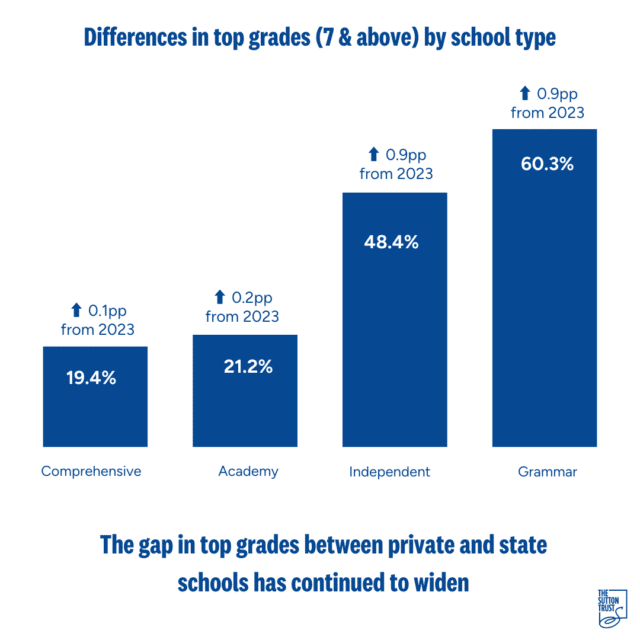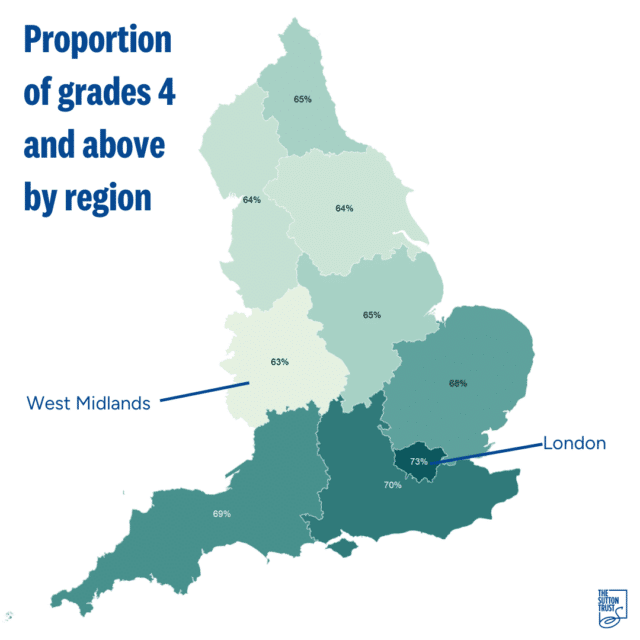News
Sir Peter Lampl, Founder of the Sutton Trust and Founder of the Education Endowment Foundation, said:
“Youngsters receiving their GCSE results should be proud of their achievements, especially considering the major disruption this generation has faced in recent years.
“It is concerning that the gap in attainment between private and state schools has widened this year. This reflects a broader pattern of widening gaps between the most and least well-off young people since the pandemic and cost of living crisis.
“The stubborn regional disparities in attainment are unchanged. London continues to outperform the rest of the country, and the North East is still the region with the lowest level of top grades. Looking at pass rates (grade 4 and above), all regions have seen drops, but the West Midlands, which had the lowest rate of passes last year, has dropped the most.
“To close these gaps and enable all pupils to reach their potential, we need to see sustained investment in teaching, particularly in areas with lower attainment.”
Summary
- Grades in England are very similar to last year, with Wales and Northern Ireland seeing drops as they complete their return to pre-pandemic grading.
- In England, top grades increased slightly, whereas passing grades decreased. This year, 21.7% of grades were at 7 and above, up slightly from 21.6% in 2023 and 20.7% in 2019. In terms of passing grades (4 and above) the figure was 67.4%, down from 67.8% in 2023, but still up from 67.1% in 2019.
- In contrast, at grade 7/A Wales dropped from 21.7% to 19.2%, and Northern Ireland from 34.5% to 31%, as part of their more gradual strategy to reverse inflation following the pandemic.
- The private/state gap in top grades has increased compared to last year. 48.4% of grades in independent schools were at A/7 or higher, up from 47.5% last year. In contrast, at academies it rose slightly from 21% to 21.2%, and at comprehensives 19.3% to 19.4%. This means the gap between independent and comprehensive schools rose from 28.2 percentage points to 29 percentage points. Grammar schools similarly saw bigger rises than non-selective schools.
- At higher grades, London’s position is unchanged since last year, however at grades 4 and above, London had the joint smallest fall, with West Midlands, which already had the lowest pass rate, falling the most, down 0.8 percentage points to 63.1, with London only down 0.1 percentage points to 72.5.
- The North East still has the lowest levels of the highest grades, but has continued to slowly catch up with other regions.
- The gap between girls and boys reduced slightly. For 16 year old entrants, at grade 7/A and above by 0.2 percentage points, and at grade 4/C by 0.1pp.
- The National Reference Test, which is used to compare performance across years using a consistent test, showed English scores went down this year, and remain below pre-pandemic levels, while performance in maths increased.

